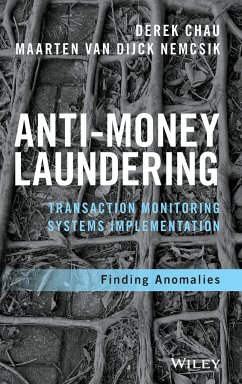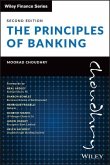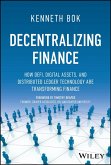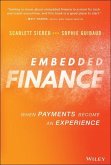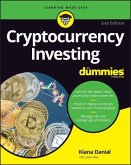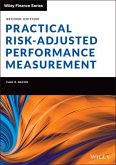Derek Chau, Maarten van Dijck Nemcsik
Anti-Money Laundering Transaction Monitoring Systems Implementation
Finding Anomalies
Schade – dieser Artikel ist leider ausverkauft. Sobald wir wissen, ob und wann der Artikel wieder verfügbar ist, informieren wir Sie an dieser Stelle.
Derek Chau, Maarten van Dijck Nemcsik
Anti-Money Laundering Transaction Monitoring Systems Implementation
Finding Anomalies
- Gebundenes Buch
- Merkliste
- Auf die Merkliste
- Bewerten Bewerten
- Teilen
- Produkt teilen
- Produkterinnerung
- Produkterinnerung
Effective transaction monitoring begins with proper implementation Anti-Money Laundering Transaction Monitoring Systems Implementation provides comprehensive guidance for bank compliance and IT personnel tasked with implementing AML transaction monitoring.
Andere Kunden interessierten sich auch für
![The Principles of Banking The Principles of Banking]() Moorad ChoudhryThe Principles of Banking71,99 €
Moorad ChoudhryThe Principles of Banking71,99 €![Decentralizing Finance Decentralizing Finance]() Kenneth Bok (UK Imperial College LondonDecentralizing Finance28,99 €
Kenneth Bok (UK Imperial College LondonDecentralizing Finance28,99 €![Defi and the Future of Finance Defi and the Future of Finance]() Campbell R. Harvey (Duke University, Durham, NC)Defi and the Future of Finance28,99 €
Campbell R. Harvey (Duke University, Durham, NC)Defi and the Future of Finance28,99 €![Cryptodad Cryptodad]() J. Christopher GiancarloCryptodad20,99 €
J. Christopher GiancarloCryptodad20,99 €![Embedded Finance Embedded Finance]() Scarlett SieberEmbedded Finance20,99 €
Scarlett SieberEmbedded Finance20,99 €![Cryptocurrency Investing for Dummies Cryptocurrency Investing for Dummies]() Kiana DanialCryptocurrency Investing for Dummies29,99 €
Kiana DanialCryptocurrency Investing for Dummies29,99 €![Practical Risk-Adjusted Performance Measurement Practical Risk-Adjusted Performance Measurement]() Carl R. Bacon (Confluence)Practical Risk-Adjusted Performance Measurement88,99 €
Carl R. Bacon (Confluence)Practical Risk-Adjusted Performance Measurement88,99 €-
-
-
Effective transaction monitoring begins with proper implementation Anti-Money Laundering Transaction Monitoring Systems Implementation provides comprehensive guidance for bank compliance and IT personnel tasked with implementing AML transaction monitoring.
Produktdetails
- Produktdetails
- Wiley and SAS Business Series
- Verlag: Wiley / Wiley & Sons
- Artikelnr. des Verlages: 1W119381800
- 1. Auflage
- Seitenzahl: 304
- Erscheinungstermin: 30. Dezember 2020
- Englisch
- Abmessung: 235mm x 157mm x 21mm
- Gewicht: 560g
- ISBN-13: 9781119381808
- ISBN-10: 1119381800
- Artikelnr.: 47122321
- Herstellerkennzeichnung
- Libri GmbH
- Europaallee 1
- 36244 Bad Hersfeld
- gpsr@libri.de
- Wiley and SAS Business Series
- Verlag: Wiley / Wiley & Sons
- Artikelnr. des Verlages: 1W119381800
- 1. Auflage
- Seitenzahl: 304
- Erscheinungstermin: 30. Dezember 2020
- Englisch
- Abmessung: 235mm x 157mm x 21mm
- Gewicht: 560g
- ISBN-13: 9781119381808
- ISBN-10: 1119381800
- Artikelnr.: 47122321
- Herstellerkennzeichnung
- Libri GmbH
- Europaallee 1
- 36244 Bad Hersfeld
- gpsr@libri.de
CHAU CHAN YIP (DEREK) is Principal Technical Consultant at SAS Hong Kong since 2010. He was formerly a Technology Consultant at Hewlett Packard. He specializes in data integration and anti-money laundering. He received his Master of Science degree in Computer Science from the Chinese University of Hong Kong. MAARTEN VAN DIJCK NEMCSIK, LLM, PHD, has worked with SAS since 2012 as a financial crime and tax compliance domain expert and solution lead. He is part of the SAS Global Fraud & Security Business Intelligence Unit, responsible for internal and external training courses in the financial crime and compliance space.
About the Authors xiii
Acknowledgments xv
Preface xvii
Chapter 1 An Introduction to Anti-Money Laundering 1
The Emergence of AML 2
AML as a Compliance Domain 5
The Objectives of AML 9
Regulatory Reporting 9
Corporate Citizenship versus Profitability 10
About True and False Positives and Negatives 11
The Evolution of Automated Transaction Monitoring 15
From Rule-Based to Risk-Based 17
From Static to More Dynamic Transaction Monitoring 22
Latest Trends: Machine Learning and Artificial Intelligence 26
Latest Trends: Blockchain 29
Risk-Based Granularity and Statistical Relevance 34
Summary 36
Chapter 2 Transaction Monitoring in Different Businesses 39
Banking 43
Correspondent Banking 46
Banking - Trade Finance 49
Banking - Credit Card 60
Insurance 60
Securities 63
Stored Value Facilities (SVFs) 66
Casinos and Online Gambling 68
Lottery and Jockey Club 70
Other Businesses 72
Summary 72
Chapter 3 The Importance of Data 75
ETL: Extract, Transform, and Load 76
Extract: Data Availability and Sourcing 77
Transform: Data Quality, Conversion, and Repair 80
Data Load and Further Processing 89
Loading of the Data 89
Data Lineage 92
Multiple ETLs 92
Summary 93
Chapter 4 Typical Scenario Elements 95
Transaction Types 96
Actionable Entity 100
Scenario Parameters 106
Use of Maximum Instead of Minimum Value Threshold 108
Threshold per Customer 109
Pre-Computing Data 110
Timeliness of Alerts 112
Use of Ratios 114
Ratio as Degree of Change/Similarity 117
Ratio as Proportion 119
Other Common Issues 120
Chapter 5 Scenarios in Detail 121
Large Aggregate Value 122
Unexpected Transaction 123
High Velocity/Turnover 129
Turnaround/Round-Tripping 132
Structuring 136
Early Termination/Quick Reciprocal Action 141
Watchlist 141
Common Specifications across Unrelated Entities 142
Involving Unrelated Third Party 144
One-to-Many 144
Transacting Just below Reporting Threshold 145
Chapter 6 The Selection of Scenarios 147
Selecting Scenarios 148
Regulatory Requirements 148
Business Drivers 150
Data Quality and Availability of Reference Data 152
Maintenance of the Scenario Repository 152
How Specific should a Scenario Rule Be? 153
Overlapping Scenario Rules 155
Summary 156
Chapter 7 Entity Resolution and Watchlist Matching 157
Entity Resolution 158
Watchlists 161
Summary 184
Chapter 8 Customer Segmentation 185
The Need for Segmenting Customers 186
Approaches to Segmentation 188
Overview of Segmentation Steps 191
Organizational Profiling 193
Common Segmentation Dimensions 195
Considerations in Defining Segments 197
Check Source Data for Segmentation 199
Verify with Statistical Analysis 200
Ongoing Monitoring 205
Change of Segmentation 205
Summary 207
Chapter 9 Scenario Threshold Tuning 209
The Need for Tuning 210
Parameters and Thresholds 210
True versus False, Positive versus Negative 212
Cost 213
&nbs
Acknowledgments xv
Preface xvii
Chapter 1 An Introduction to Anti-Money Laundering 1
The Emergence of AML 2
AML as a Compliance Domain 5
The Objectives of AML 9
Regulatory Reporting 9
Corporate Citizenship versus Profitability 10
About True and False Positives and Negatives 11
The Evolution of Automated Transaction Monitoring 15
From Rule-Based to Risk-Based 17
From Static to More Dynamic Transaction Monitoring 22
Latest Trends: Machine Learning and Artificial Intelligence 26
Latest Trends: Blockchain 29
Risk-Based Granularity and Statistical Relevance 34
Summary 36
Chapter 2 Transaction Monitoring in Different Businesses 39
Banking 43
Correspondent Banking 46
Banking - Trade Finance 49
Banking - Credit Card 60
Insurance 60
Securities 63
Stored Value Facilities (SVFs) 66
Casinos and Online Gambling 68
Lottery and Jockey Club 70
Other Businesses 72
Summary 72
Chapter 3 The Importance of Data 75
ETL: Extract, Transform, and Load 76
Extract: Data Availability and Sourcing 77
Transform: Data Quality, Conversion, and Repair 80
Data Load and Further Processing 89
Loading of the Data 89
Data Lineage 92
Multiple ETLs 92
Summary 93
Chapter 4 Typical Scenario Elements 95
Transaction Types 96
Actionable Entity 100
Scenario Parameters 106
Use of Maximum Instead of Minimum Value Threshold 108
Threshold per Customer 109
Pre-Computing Data 110
Timeliness of Alerts 112
Use of Ratios 114
Ratio as Degree of Change/Similarity 117
Ratio as Proportion 119
Other Common Issues 120
Chapter 5 Scenarios in Detail 121
Large Aggregate Value 122
Unexpected Transaction 123
High Velocity/Turnover 129
Turnaround/Round-Tripping 132
Structuring 136
Early Termination/Quick Reciprocal Action 141
Watchlist 141
Common Specifications across Unrelated Entities 142
Involving Unrelated Third Party 144
One-to-Many 144
Transacting Just below Reporting Threshold 145
Chapter 6 The Selection of Scenarios 147
Selecting Scenarios 148
Regulatory Requirements 148
Business Drivers 150
Data Quality and Availability of Reference Data 152
Maintenance of the Scenario Repository 152
How Specific should a Scenario Rule Be? 153
Overlapping Scenario Rules 155
Summary 156
Chapter 7 Entity Resolution and Watchlist Matching 157
Entity Resolution 158
Watchlists 161
Summary 184
Chapter 8 Customer Segmentation 185
The Need for Segmenting Customers 186
Approaches to Segmentation 188
Overview of Segmentation Steps 191
Organizational Profiling 193
Common Segmentation Dimensions 195
Considerations in Defining Segments 197
Check Source Data for Segmentation 199
Verify with Statistical Analysis 200
Ongoing Monitoring 205
Change of Segmentation 205
Summary 207
Chapter 9 Scenario Threshold Tuning 209
The Need for Tuning 210
Parameters and Thresholds 210
True versus False, Positive versus Negative 212
Cost 213
&nbs
About the Authors xiii
Acknowledgments xv
Preface xvii
Chapter 1 An Introduction to Anti-Money Laundering 1
The Emergence of AML 2
AML as a Compliance Domain 5
The Objectives of AML 9
Regulatory Reporting 9
Corporate Citizenship versus Profitability 10
About True and False Positives and Negatives 11
The Evolution of Automated Transaction Monitoring 15
From Rule-Based to Risk-Based 17
From Static to More Dynamic Transaction Monitoring 22
Latest Trends: Machine Learning and Artificial Intelligence 26
Latest Trends: Blockchain 29
Risk-Based Granularity and Statistical Relevance 34
Summary 36
Chapter 2 Transaction Monitoring in Different Businesses 39
Banking 43
Correspondent Banking 46
Banking - Trade Finance 49
Banking - Credit Card 60
Insurance 60
Securities 63
Stored Value Facilities (SVFs) 66
Casinos and Online Gambling 68
Lottery and Jockey Club 70
Other Businesses 72
Summary 72
Chapter 3 The Importance of Data 75
ETL: Extract, Transform, and Load 76
Extract: Data Availability and Sourcing 77
Transform: Data Quality, Conversion, and Repair 80
Data Load and Further Processing 89
Loading of the Data 89
Data Lineage 92
Multiple ETLs 92
Summary 93
Chapter 4 Typical Scenario Elements 95
Transaction Types 96
Actionable Entity 100
Scenario Parameters 106
Use of Maximum Instead of Minimum Value Threshold 108
Threshold per Customer 109
Pre-Computing Data 110
Timeliness of Alerts 112
Use of Ratios 114
Ratio as Degree of Change/Similarity 117
Ratio as Proportion 119
Other Common Issues 120
Chapter 5 Scenarios in Detail 121
Large Aggregate Value 122
Unexpected Transaction 123
High Velocity/Turnover 129
Turnaround/Round-Tripping 132
Structuring 136
Early Termination/Quick Reciprocal Action 141
Watchlist 141
Common Specifications across Unrelated Entities 142
Involving Unrelated Third Party 144
One-to-Many 144
Transacting Just below Reporting Threshold 145
Chapter 6 The Selection of Scenarios 147
Selecting Scenarios 148
Regulatory Requirements 148
Business Drivers 150
Data Quality and Availability of Reference Data 152
Maintenance of the Scenario Repository 152
How Specific should a Scenario Rule Be? 153
Overlapping Scenario Rules 155
Summary 156
Chapter 7 Entity Resolution and Watchlist Matching 157
Entity Resolution 158
Watchlists 161
Summary 184
Chapter 8 Customer Segmentation 185
The Need for Segmenting Customers 186
Approaches to Segmentation 188
Overview of Segmentation Steps 191
Organizational Profiling 193
Common Segmentation Dimensions 195
Considerations in Defining Segments 197
Check Source Data for Segmentation 199
Verify with Statistical Analysis 200
Ongoing Monitoring 205
Change of Segmentation 205
Summary 207
Chapter 9 Scenario Threshold Tuning 209
The Need for Tuning 210
Parameters and Thresholds 210
True versus False, Positive versus Negative 212
Cost 213
&nbs
Acknowledgments xv
Preface xvii
Chapter 1 An Introduction to Anti-Money Laundering 1
The Emergence of AML 2
AML as a Compliance Domain 5
The Objectives of AML 9
Regulatory Reporting 9
Corporate Citizenship versus Profitability 10
About True and False Positives and Negatives 11
The Evolution of Automated Transaction Monitoring 15
From Rule-Based to Risk-Based 17
From Static to More Dynamic Transaction Monitoring 22
Latest Trends: Machine Learning and Artificial Intelligence 26
Latest Trends: Blockchain 29
Risk-Based Granularity and Statistical Relevance 34
Summary 36
Chapter 2 Transaction Monitoring in Different Businesses 39
Banking 43
Correspondent Banking 46
Banking - Trade Finance 49
Banking - Credit Card 60
Insurance 60
Securities 63
Stored Value Facilities (SVFs) 66
Casinos and Online Gambling 68
Lottery and Jockey Club 70
Other Businesses 72
Summary 72
Chapter 3 The Importance of Data 75
ETL: Extract, Transform, and Load 76
Extract: Data Availability and Sourcing 77
Transform: Data Quality, Conversion, and Repair 80
Data Load and Further Processing 89
Loading of the Data 89
Data Lineage 92
Multiple ETLs 92
Summary 93
Chapter 4 Typical Scenario Elements 95
Transaction Types 96
Actionable Entity 100
Scenario Parameters 106
Use of Maximum Instead of Minimum Value Threshold 108
Threshold per Customer 109
Pre-Computing Data 110
Timeliness of Alerts 112
Use of Ratios 114
Ratio as Degree of Change/Similarity 117
Ratio as Proportion 119
Other Common Issues 120
Chapter 5 Scenarios in Detail 121
Large Aggregate Value 122
Unexpected Transaction 123
High Velocity/Turnover 129
Turnaround/Round-Tripping 132
Structuring 136
Early Termination/Quick Reciprocal Action 141
Watchlist 141
Common Specifications across Unrelated Entities 142
Involving Unrelated Third Party 144
One-to-Many 144
Transacting Just below Reporting Threshold 145
Chapter 6 The Selection of Scenarios 147
Selecting Scenarios 148
Regulatory Requirements 148
Business Drivers 150
Data Quality and Availability of Reference Data 152
Maintenance of the Scenario Repository 152
How Specific should a Scenario Rule Be? 153
Overlapping Scenario Rules 155
Summary 156
Chapter 7 Entity Resolution and Watchlist Matching 157
Entity Resolution 158
Watchlists 161
Summary 184
Chapter 8 Customer Segmentation 185
The Need for Segmenting Customers 186
Approaches to Segmentation 188
Overview of Segmentation Steps 191
Organizational Profiling 193
Common Segmentation Dimensions 195
Considerations in Defining Segments 197
Check Source Data for Segmentation 199
Verify with Statistical Analysis 200
Ongoing Monitoring 205
Change of Segmentation 205
Summary 207
Chapter 9 Scenario Threshold Tuning 209
The Need for Tuning 210
Parameters and Thresholds 210
True versus False, Positive versus Negative 212
Cost 213
&nbs

